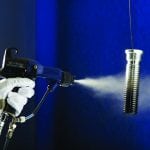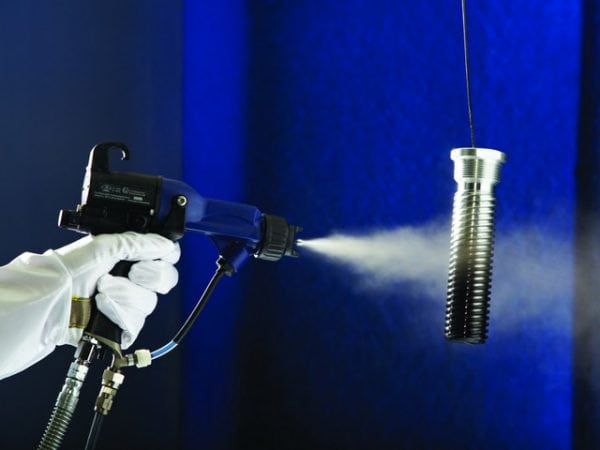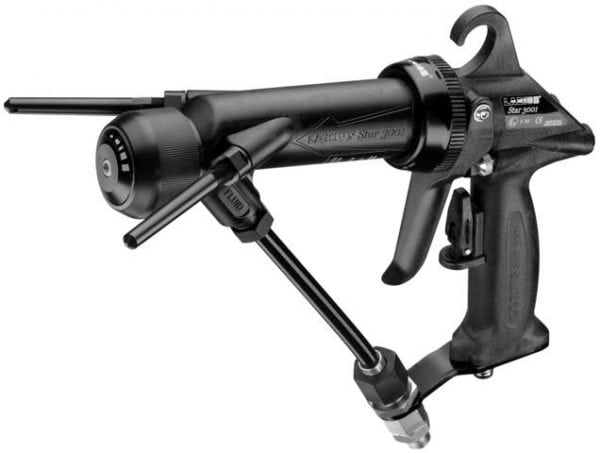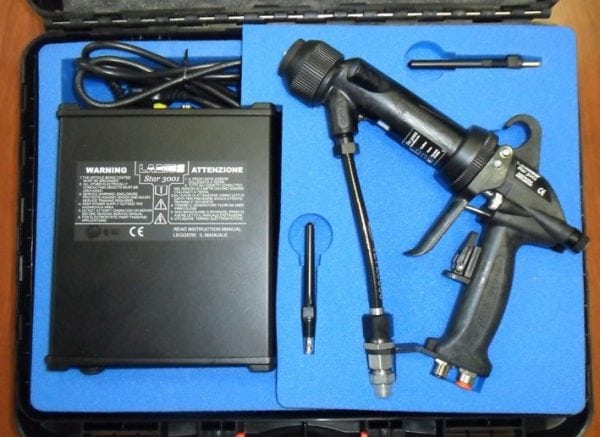Electrostatic painting is the application of paint to the surface using the forces of interaction between fixed point electric charges (Coulomb force). The paintwork material (most often based on water, but there are options with an organic solvent) is applied using a special spray gun.
Technology
The electrostatic atomizer was first used in 1941 by the American inventor G. Ransburg. The technique implied the use of electric fields along which charged particles of paint move. The liquid paint material interacts with the electrode located in the gun, as a result of which a high-voltage negative charge (60-100 kW) is transferred to the paint. Charged particles coming out of the nozzle of the spray gun are sent along the lines of the electrostatic field to the grounded product, on which the paintwork is applied.
The painting torch arises due to the mutual repulsion of the charged particles of the paint material. An important difference between this technology and other methods is that there is no need for colorful fog, since particles are directed along predetermined lines. The paint transfer coefficient can range from 70 to 98 percent. The transfer rate depends on the conductivity of the material being painted, the shape of the product and other indirect factors.
The electrostatic method reduces paintwork consumption, and the painting process itself makes it easier. When painting metal pipes in the traditional way, you need to turn the product over several times. In the case of an electrostatic gun, there is no need to turn the part, since the charged particles are guided along the lines of force and easily go around obstacles. Staining is carried out very evenly, since in the already processed place the paint repels surplus incoming material.
to contents ↑Spray types
Two types of electrostatic atomization are used - classic and cascade. The classic suggests that a high-voltage cable receives a direct current at high voltage to an electrostatic spray gun. The classical scheme has a number of significant drawbacks. First of all, we are talking about voltage instability in the pistol electrode. In addition, it’s rather inconvenient to paint, as a large cable makes it difficult to operate, and to turn off the power, you need to get to the transformer every time.
In a cascade technique, high voltage is formed not outside, but in the gun itself. A voltage of only 12 V is directed to the gun via a low-voltage cable, and high voltage generation is already taking place inside the device. The conversion is carried out on the cascade of the spray gun. The cable used is thin and flexible, making it very convenient to work with.
The cascade method allows you to turn off the flow of electricity regardless of the generator, as well as control the voltage level, choosing the suitable material for a particular type. The voltage itself is highly stable, which can significantly reduce paintwork consumption. The main disadvantage of cascade spraying is the high cost of equipment. However, the costs quickly pay off due to the cost-effectiveness of this technology.
Electrostatic spraying has some limitations dictated by the following circumstances:
- Properties of paint material. In order for the paint to be properly charged on the electrode, a resistance of at least 30 kOhm is necessary. Otherwise, the painting efficiency in the electrostatic field is drastically reduced. As an example of a paint and varnish material with a low level of resistance, compositions with significant additives of metallic powder can be cited (these include metallic enamels). Until recently, electrostatic staining was not used when applying water-soluble paints, since there was a high risk of short circuits due to the electrical conductivity of the liquid. The latest models of equipment for electrostatic staining allow you to work with water-soluble coatings.
- Material properties. Non-conductive products such as plastic and wood are difficult to paint. The process can be facilitated with the help of special conductive primers (in the case of plastic) or wetting (for wood).
- The shape of the part to be painted. As mentioned above, the electrostatic method allows you to paint products of different shapes, however, in a closed conductive circuit, the voltage of the electrostatic field is zero. Therefore, in deep recesses there is no electric field, because of which particles of paint material do not fall on such areas. Moreover, without getting into all kinds of depressions, the paint is concentrated in other areas (for example, at the edges), which leads to the formation of an overly thick coating layer. To avoid such problems (they are called the Faraday circuit), staining of inaccessible places is carried out by a conventional spray gun - airless or pneumatic.
Airbrush "Star 3001"
As an example, let’s take a look at the Star 3001 spray gun. This device uses a cascade method of generating high voltage. Both mechanical and automatic equipment modifications are made. Both models can work with both airless spray and air mixture.
Separate modifications also exist for water-soluble coatings and for solvent-based paints. Each model, depending on its purpose, can significantly differ in the materials used in it, and also have its own design features.
Thus, the range of equipment is wide, so before buying you need to decide how the electrostatic gun will be used. The device "Star 3001" is designed to work with water-based coatings. This means that the device is protected against short circuit, because the structure is made of special material. But Star 3001 is not suitable for working with an organic solvent, so you need to look for a modification whose housing is inert with respect to solvents.
The problem with the Faraday circuit in the atomizer of this model is solved by turning off the power. In the absence of power, paintwork is sprayed only under pressure. The voltage control key is located directly on the body of the spray gun, which is very convenient. In addition, you can control the pressure with your own hands - just pull the trigger. The gun is also equipped with a memory, thanks to which up to three electrostatic field options are supported for each type of paint.
An important parameter of any applied paintwork material is electrical resistance. Together with the Star 3001 apparatus, a probe is supplied that tests the paintwork materials for resistance, thereby providing the best indicator for the electrostatic field.
Despite the technical equipment, such a spray gun is easy to maintain.The case is easily disassembled, after which all mechanisms are available for visual observation. In the event of a breakdown, any parts of the gun must be replaced. This circumstance makes it possible to simplify repair work, as well as reduce their cost.
It should be noted the low weight of the device - only 900 grams. Due to its light weight, it is not physically difficult to work with the device, but due to the ergonomic handle it is also convenient.
For industrial applications, a modification of “LARIUS 2 Paint Systems” has been developed. In such a system, a double diaphragm is used, due to which the paint is pumped under low pressure.
to contents ↑Application of technology in Russia
The technology of electrostatic painting is characterized by many advantages. However, under Russian conditions, the use of electrostatic atomization has not yet found widespread application. The main reason is the lack of a sufficient number of qualified specialists. The equipment itself is distinguished by a complex device, it must be able to use it, otherwise instead of electrostatic spraying, the paint will be sprayed in the usual way, which will not give the planned effect.
Another difficulty is the search for coatings with the desired level of electrical conductivity. If the indicator will differ from the set, it can be changed, but in any case, you can not do without the initial information. At the same time, it is often impossible to find out the level of electrical conductivity either from sellers or from manufacturers. As a result, the only way out is to buy Western-made coatings, which are significantly more expensive than domestic samples.
The next important factor is ensuring good grounding. In most cases, this condition is not properly met. In the absence of grounding, the painter will paint not only the surface, but also himself.
It should also be said about one popular misconception: many painters believe that the larger the torch, the faster the surface will be painted. However, in practice, this is not so, and increasing the torch only turns the electrostatic apparatus into a regular airbrush.
Electrostatic coloring, of course, has great prospects for application. The necessary equipment is on sale, and the technology is well-studied. However, in order to spread electrostatic paint more widely, it is necessary to specially train and then test the knowledge in practice.








